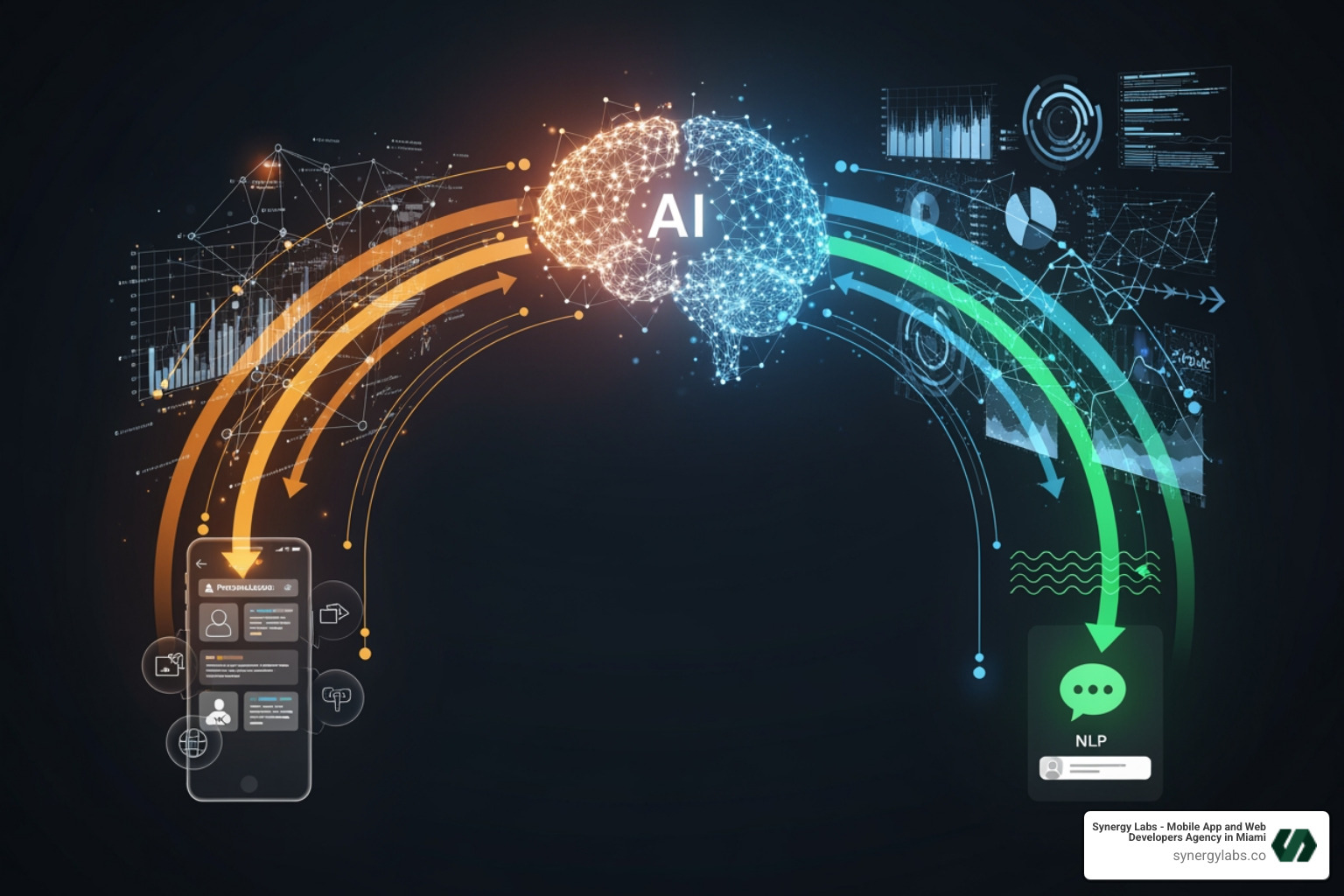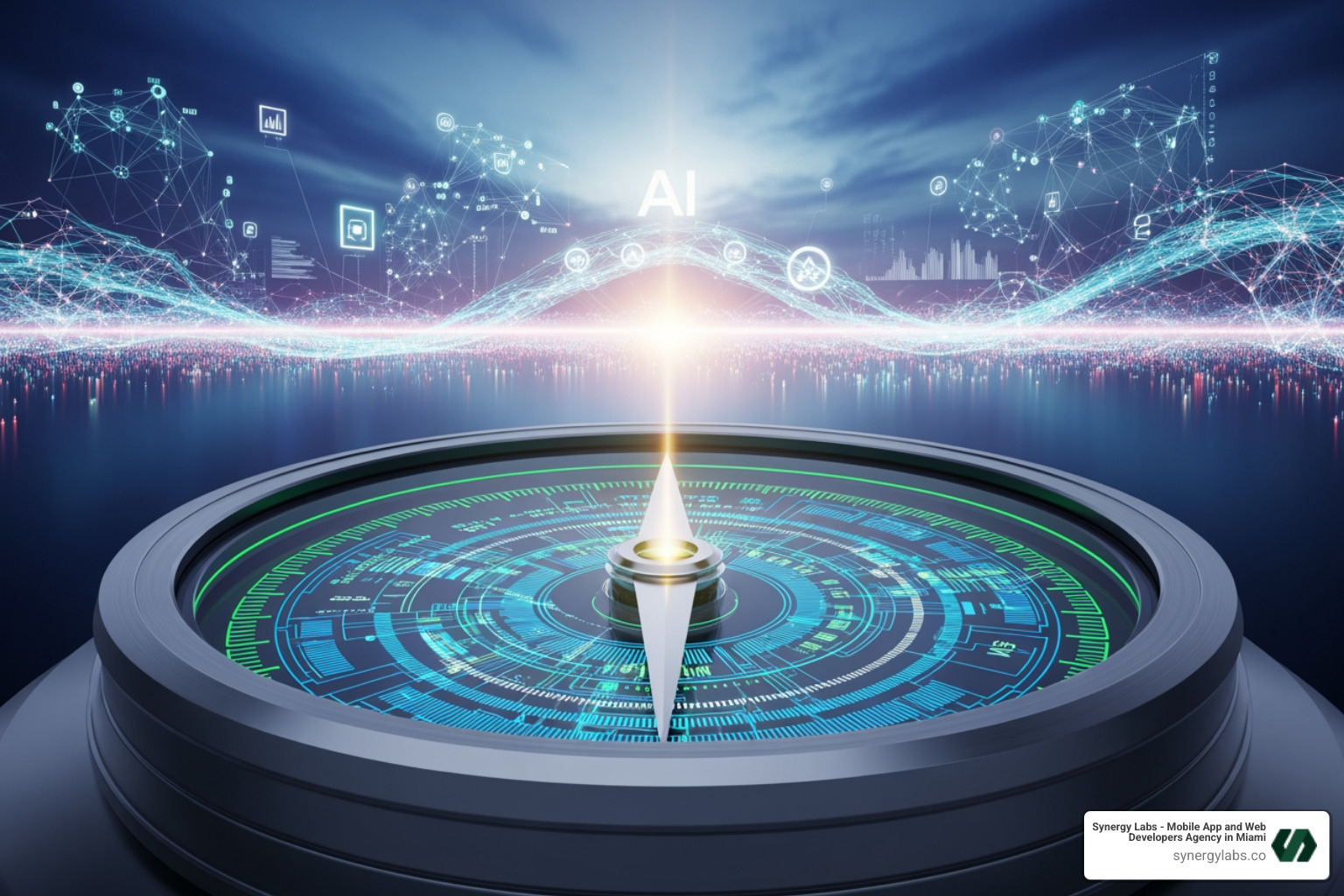Asóciese con una agencia TOP-TIER
Concierteuna reunión a través de este formulario y
le pondremos en contacto directamente con nuestro director de producto, sin vendedores de por medio.
¿Prefiere hablar ahora?
Llámenos al + 1 (645) 444 - 1069

"A decade ago, AI assistants and stress-tracking smartwatches were science fiction. Today, users expect apps to know what they want before they do."

Building Smarter Apps in 2025: AI Personalization, Predictive Models, and NLP UI is no longer an option—it's the baseline for staying competitive. User expectations have fundamentally shifted. A decade ago, AI assistants and stress-tracking smartwatches were science fiction. Today, users expect apps to know what they want before they do, from personalized playlists to predictive shopping recommendations.
The data backs this up: companies implementing AI see revenue increases of 3-15%, and apps with personalization drive 10-15% revenue lifts. The core of this shift rests on three pillars:
However, 70-85% of AI initiatives fail to deliver results. Why? Because teams treat AI as a feature instead of a core component, focusing on technology over user problems. Smart apps are different. They use AI as their foundation, not their decoration. They start with clear business goals, clean data, and user-centered design.
At Synergy Labs, we've helped companies across healthcare, fintech, and e-commerce integrate these principles into their core products, turning generic apps into adaptive platforms. This guide distills our learnings into a practical blueprint for building truly intelligent software.

What makes an app "smart"? The answer lies in three interconnected technologies: AI personalization, predictive models, and natural language processing (NLP). These aren't just buzzwords; they are the foundation of every app that feels like it truly gets you. At their core, these technologies rely on Machine Learning (ML) and Deep Learning, which teach software to recognize patterns and make sophisticated decisions from massive datasets. This transforms static apps into dynamic, data-driven experiences.

Traditional rule-based personalization is static, like a vending machine. AI-powered personalization is dynamic, like a personal chef who learns your preferences. Instead of following rigid if-this-then-that logic updated in batches, AI learns in real-time from every click, pause, and purchase to predict intent and adapt the experience instantly.
Personalization done right delivers a 10-15% revenue lift. Success depends on four components:
In e-commerce, retailers use this to increase order values and conversion rates. Leading language-learning apps have seen jumps of up to 40% in retention by adapting lessons to user performance. News aggregators build a unique "Interest Graph" for each reader. It's not about adding a single feature; it's about making the entire app responsive to the individual. For more, explore enhancing user experience through AI-powered personalization.
If personalization is about reacting to users, predictive models are about knowing what they'll do next. This is where apps become proactive, using historical data to forecast future outcomes with surprising accuracy.
Predictive models turn raw data into actionable insights, helping businesses make smarter decisions and deliver services that feel almost telepathic. Learn more about implementing these capabilities in enterprise solutions.
Most app interfaces force users to learn a new language of menus and buttons. Natural Language Processing (NLP) flips this, allowing apps to understand human language. When integrated into the UI, it transforms mechanical interactions into conversational ones.
NLP UI meets users where they are, requiring no manual to read. Together, these three pillars—AI personalization, predictive models, and NLP UI—are what make Building Smarter Apps in 2025: AI Personalization, Predictive Models, and NLP UI the new standard. For a technical deep-dive, see how natural language systems work.
We've covered the technology. Now, let's get to the bottom line: why should your business invest in Building Smarter Apps in 2025: AI Personalization, Predictive Models, and NLP UI, and how do you actually do it? The answer is a combination of a compelling business case and a clear, actionable roadmap.

Investing in AI isn't about chasing trends; it's about improving how your business operates and how users experience your product. The outcomes are measurable and transformative.
Building an AI-powered app is achievable with a structured approach. Here's the blueprint we follow:
Budget and timeline depend on several factors, but we can provide clear benchmarks.
Cost Ranges:
Timelines:
At Synergy Labs, we provide transparent projections custom to your needs, ensuring you understand the investment and expected returns. For more context, see AI for enterprise solutions.
The promise of Building Smarter Apps in 2025: AI Personalization, Predictive Models, and NLP UI is immense, but the path has challenges. Understanding these obstacles and staying ahead of trends is essential for protecting your investment and ensuring long-term success.

Most AI project pitfalls are avoidable with the right approach. Here are the most common ones we see across our clients from Miami to Dubai:
Navigating these challenges requires experience and strategic thinking. For more on this, explore Balancing speed with scaling.
The AI landscape evolves rapidly. Here are the trends that will reshape intelligent applications by 2025 and beyond.
These trends point to a future where apps are genuinely intelligent and adaptive. To stay informed on these shifts, check out The future of innovation. Companies that accept these trends will define the next generation of mobile experiences.
We hear these questions all the time from clients in Miami, Dubai, San Francisco, and beyond. Let's tackle the big ones head-on.
No, AI won't replace developers. It will, however, fundamentally change their jobs for the better. Think of AI as the world's most capable assistant, handling tedious tasks like generating boilerplate code, running automated tests, and suggesting optimizations.
This frees developers to focus on what humans do best: creative problem-solving, strategic thinking, and complex architectural design. At Synergy Labs, our developers use AI tools to accelerate workflows, allowing them to innovate on features that truly differentiate our clients' apps. The developers who accept AI as a tool will become exponentially more productive and valuable.
Costs vary dramatically based on complexity, but here are some general ranges. A simple AI app or MVP using pre-trained APIs typically costs $20,000 to $50,000. These are great for validating concepts quickly.
An intermediate solution with some custom model training and system integration usually falls between $50,000 and $150,000. For advanced, enterprise-grade AI applications with fully custom models and real-time analytics, budgets often exceed $200,000.
The biggest cost drivers are data preparation (which can be 30-40% of project time), model complexity, and team expertise. At Synergy Labs, we provide transparent cost breakdowns custom to your specific needs, whether you're a startup in Austin or an enterprise in London.
Absolutely. This is often the smartest way to start your Building Smarter Apps in 2025: AI Personalization, Predictive Models, and NLP UI journey. You don't need to rebuild from scratch.
Many of our clients begin by integrating pre-built AI APIs for high-impact features like a customer support chatbot, voice search, or basic personalized recommendations. This incremental approach is lower-risk, delivers value to users faster, and allows you to test and learn before committing to a massive overhaul.
We've helped companies from New York City to Doha follow this exact path—starting small, measuring impact, and expanding intelligently. The key is having a clear vision and a partner who can help you map out a phased approach that aligns with your business goals.
The era of static, one-size-fits-all applications is over. The apps that will thrive in 2025 and beyond are those that learn, adapt, and anticipate—feeling less like tools and more like intelligent partners.
We've explored the three pillars that make this possible: AI personalization to create unique user experiences, predictive models to turn data into foresight, and NLP interfaces to make technology feel natural. The business case is clear, with measurable improvements in engagement, retention, and productivity.
While the path has challenges like data privacy and algorithmic bias, the future is even more promising. Trends like Agentic AI, Multimodal capabilities, and Edge AI will continue to redefine what's possible, making apps more autonomous, intuitive, and responsive.
At Synergy Labs, we've helped businesses across healthcare, fintech, and e-commerce transform their applications into intelligent platforms. We partner with clients in Miami, Dubai, San Francisco, New York City, London, and our other global locations, guiding them from concept through launch and beyond.
What sets us apart is our commitment to personalized service with direct access to senior talent. We don't treat AI as a buzzword; we build it into the foundation of your app with clear goals and user-centered design. The question isn't whether AI will become the standard for app development. It already is. The question is whether you'll lead this change or scramble to catch up.
Ready to build an app that not only serves users but anticipates their needs? You need a partner with deep expertise in both mobile development and AI integration. Start building your intelligent app with Synergy Builder today.

Empezar es muy fácil. Póngase en contacto con nosotros compartiendo su idea a través de nuestro formulario de contacto. Uno de los miembros de nuestro equipo le responderá en el plazo de un día laborable por correo electrónico o teléfono para hablar de su proyecto en detalle. Estaremos encantados de ayudarle a hacer realidad su visión.
Elegir SynergyLabs significa asociarse con una agencia de desarrollo de aplicaciones móviles boutique de primer nivel que prioriza sus necesidades. Nuestro equipo con sede en Estados Unidos se dedica a la entrega de aplicaciones de alta calidad, escalables y multiplataforma de forma rápida y asequible. Nos centramos en el servicio personalizado, asegurándonos de que trabaje directamente con los mejores profesionales durante todo el proyecto. Nuestro compromiso con la innovación, la satisfacción del cliente, y la comunicación transparente nos diferencia de otras agencias. Con SynergyLabs, usted puede confiar en que su visión será llevada a la vida con experiencia y cuidado.
Normalmente lanzamos aplicaciones en un plazo de 6 a 8 semanas, dependiendo de la complejidad y las características de su proyecto. Nuestro ágil proceso de desarrollo garantiza que puedas lanzar tu aplicación al mercado rápidamente sin renunciar a un producto de alta calidad.
Nuestro método de desarrollo multiplataforma nos permite crear aplicaciones web y móviles simultáneamente. Esto significa que su aplicación móvil estará disponible tanto en iOS como en Android, lo que garantiza un amplio alcance y una experiencia de usuario fluida en todos los dispositivos. Nuestro enfoque le ayuda a ahorrar tiempo y recursos al tiempo que maximiza el potencial de su aplicación.
En SynergyLabs, utilizamos una variedad de lenguajes de programación y marcos para adaptarse mejor a las necesidades de su proyecto. Para el desarrollo multiplataforma, utilizamos Flutter o Flutterflow, lo que nos permite apoyar de manera eficiente web, Android y iOS con un solo código base, ideal para proyectos con presupuestos ajustados. Para aplicaciones nativas, empleamos Swift para iOS y Kotlin para aplicaciones Android.




Para las aplicaciones web, combinamos marcos de diseño frontales como Ant Design o Material Design con React. En el backend, solemos utilizar Laravel o Yii2 para proyectos monolíticos, y Node.js para arquitecturas sin servidor.






Además, podemos dar soporte a diversas tecnologías, como Microsoft Azure, Google Cloud, Firebase, Amazon Web Services (AWS), React Native, Docker, NGINX, Apache, etc. Este variado conjunto de habilidades nos permite ofrecer soluciones sólidas y escalables adaptadas a sus requisitos específicos.








La seguridad es una prioridad para nosotros. Aplicamos medidas de seguridad estándar del sector, como el cifrado de datos, prácticas de codificación seguras y auditorías de seguridad periódicas, para proteger tu aplicación y los datos de los usuarios.
Sí, ofrecemos asistencia, mantenimiento y actualizaciones continuas para su aplicación. Una vez finalizado el proyecto, recibirá hasta 4 semanas de mantenimiento gratuito para garantizar que todo funcione correctamente. Tras este periodo, te ofrecemos opciones flexibles de asistencia continua adaptadas a tus necesidades, para que puedas centrarte en hacer crecer tu negocio mientras nosotros nos encargamos del mantenimiento y las actualizaciones de tu aplicación.